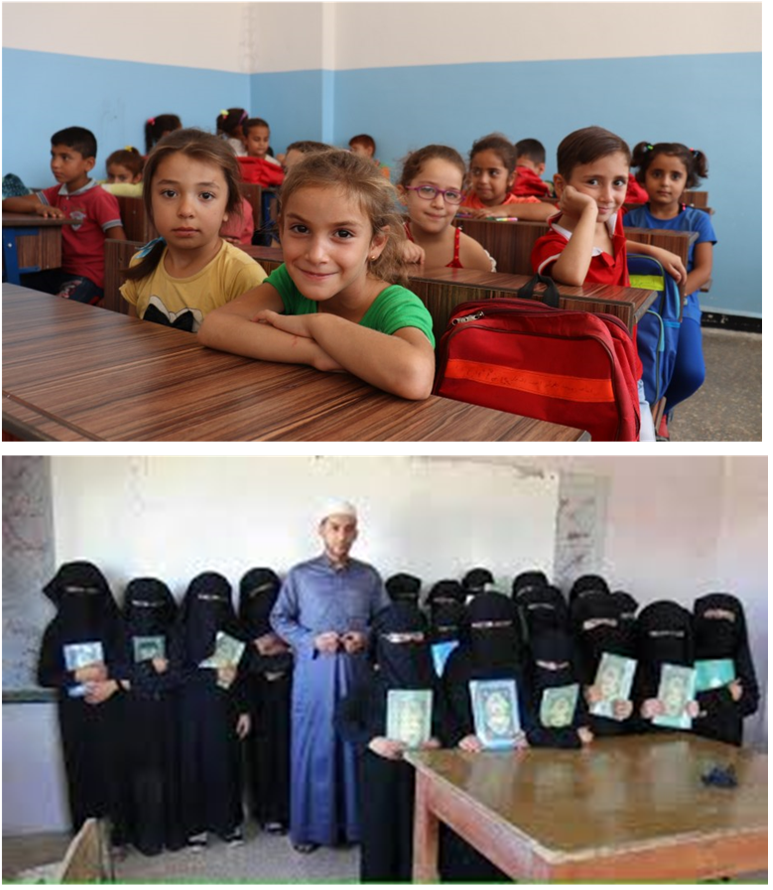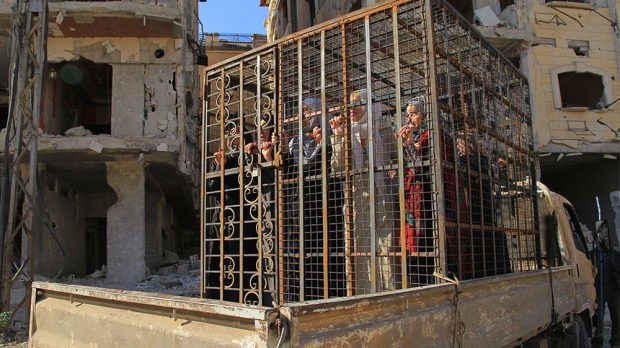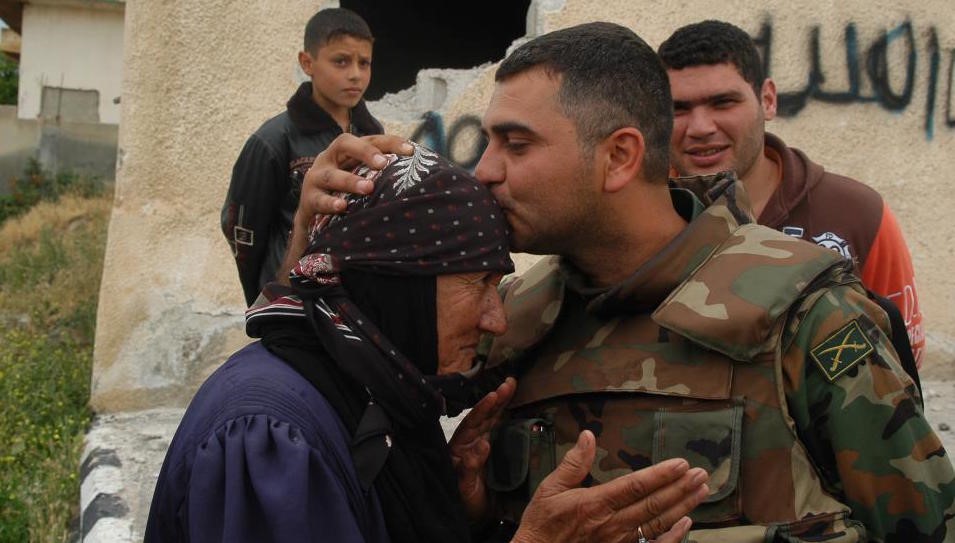by Robert PARRY 11 November 2017
Source: Strategic Culture Foundation
A new United Nations-sponsored report on the April 4 sarin incident in an Al Qaeda-controlled town in Syria blames Bashar al-Assad’s government for the atrocity, but the report contains evidence deep inside its “Annex II” that would prove Assad’s innocence.
If you read that far, you would find that more than 100 victims of sarin exposure were taken to several area hospitals before the alleged Syrian warplane could have struck the town of Khan Sheikhoun.
Still, the Joint Investigative Mechanism [JIM], a joint project of the U.N. and the Organization for the Prohibition of Chemical Weapons [OPCW], brushed aside this startling evidence and delivered the Assad guilty verdict that the United States and its allies wanted.
The JIM consigned the evidence of a staged atrocity, in which Al Qaeda operatives would have used sarin to kill innocent civilians and pin the blame on Assad, to a spot 14 pages into the report’s Annex II. The sensitivity of this evidence of a staged “attack” is heightened by the fact that President Trump rushed to judgment and ordered a “retaliatory” strike with 59 Tomahawk missiles on a Syrian airbase on the night of April 6-7. That U.S. attack reportedly killed several soldiers at the base and nine civilians, including four children, in nearby neighborhoods.
So, if it becomes clear that Al Qaeda tricked President Trump not only would he be responsible for violating international law and killing innocent people, but he and virtually the entire Western political establishment along with the major news media would look like Al Qaeda’s “useful idiots.”
Currently, the West and its mainstream media are lambasting the Russians for not accepting the JIM’s “assessment,” which blames Assad for the sarin attack. Russia is also taking flak for questioning continuation of the JIM’s mandate. There has been virtually no mainstream skepticism about the JIM’s report and almost no mention in the mainstream of the hospital-timing discrepancy.
Timing Troubles
To establish when the supposed sarin attack occurred on April 4, the JIM report relied on witnesses in the Al Qaeda-controlled town and a curious video showing three plumes of smoke but no airplanes. Based on the video’s metadata, the JIM said the scene was recorded between 0642 and 0652 hours. The JIM thus puts the timing of the sarin release at between 0630 and 0700 hours.
But the first admissions of victims to area hospitals began as early as 0600 hours, the JIM found, meaning that these victims could not have been poisoned by the alleged aerial bombing (even if the airstrike really did occur).
According to the report’s Annex II, “The admission times of the records range between 0600 and 1600 hours.” And these early cases – arriving before the alleged airstrike – were not isolated ones.
“Analysis of the … medical records revealed that in 57 cases, patients were admitted in five hospitals before the incident in Khan Shaykhun,” Annex II said.
Plus, this timing discrepancy was not limited to a few hospitals in and around Khan Sheikhoun, but was recorded as well at hospitals that were scattered across the area and included one hospital that would have taken an hour or so to reach.
Annex II stated: “In 10 such cases, patients appear to have been admitted to a hospital 125 km away from Khan Shaykhun at 0700 hours while another 42 patients appear to have been admitted to a hospital 30 km away at 0700 hours.”
In other words, more than 100 patients would appear to have been exposed to sarin before the alleged Syrian warplane could have dropped the alleged bomb and the victims could be evacuated, a finding that alone would have destroyed the JIM’s case against the Syrian government.
But the JIM seemed more interested in burying this evidence of Al Qaeda staging the incident — and killing some expendable civilians — than in following up this timing problem.
“The [JIM] did not investigate these discrepancies and cannot determine whether they are linked to any possible staging scenario, or to poor record-keeping in chaotic conditions,” the report said. But the proffered excuse about poor record-keeping would have to apply to multiple hospitals over a wide area all falsely recording the arrival time of more than 100 patients.
The video of the plumes of smoke also has come under skepticism from Theodore Postol, a weapons expert at the Massachusetts Institute of Technology, who noted that none of the three plumes matched up with damage to buildings (as viewed from satellite images) that would have resulted from aerial bombs of that power.
Postol’s finding suggests that the smoke could have been another part of a staging event rather than debris kicked up by aerial bombs.
The JIM also could find no conclusive evidence that a Syrian warplane was over Khan Sheikhoun at the time of the video although the report claims that a plane could have come within about 5 kilometers of the town.
A History of Deception
Perhaps even more significantly, the JIM report ignored the context of the April 4 case and the past history of Al Qaeda’s Nusra Front staging chemical weapons attacks with the goal of foisting blame on the Syrian government and tricking the U.S. military into an intervention on the side of Nusra and its Islamic-militant allies.
On April 4, there was a strong motive for Al Qaeda and its regional allies to mount a staged event. Just days earlier, President Trump’s administration had shocked the Syrian rebels and their backers by declaring “regime change” was no longer the U.S. goal in Syria.
So, Al Qaeda and its regional enablers were frantic to reverse Trump’s decision, which was accomplished by his emotional reaction to videos on cable news showing children and other civilians suffering and dying in Khan Sheikhoun.
On the night of April 6-7, before any thorough investigation could be conducted, Trump ordered 59 Tomahawk missiles fired at the Syrian air base that supposedly had launched the sarin attack.
At the time, I was told by an intelligence source that at least some CIA analysts believed that the sarin incident indeed had been staged with sarin possibly flown in by drone from a Saudi-Israeli special operations base in Jordan.
This source said the on-the-ground staging for the incident had been hasty because of the surprise announcement that the Trump administration was no longer seeking regime change in Damascus. The haste led to some sloppiness in tying down all the necessary details to pin the atrocity on Assad, the source said.
But the few slip-ups, such as the apparent failure to coordinate the timing of the hospital admissions to after the purported airstrike, didn’t deter the JIM investigators from backing the West’s desire to blame Assad and also create another attack line against the Russians.
Similarly, other U.N.-connected investigators downplayed earlier evidence that Al Qaeda’s Nusra was staging chemical weapons incidents after President Obama laid down his “red line” on chemical weapons. The militants apparently hoped that the U.S. military would take out the Syrian military and pave the way for an Al Qaeda victory.
For instance, U.N. investigators learned from a number of townspeople of Al-Tamanah about how the rebels and allied “activists” staged a chlorine gas attack on the night of April 29-30, 2014, and then sold the false story to a credulous Western media and, initially, to a U.N. investigative team.
“Seven witnesses stated that frequent alerts [about an imminent chlorine weapons attack by the government] had been issued, but in fact no incidents with chemicals took place,” the U.N. report said. “While people sought safety after the warnings, their homes were looted and rumours spread that the events were being staged. … [T]hey [these witnesses] had come forward to contest the wide-spread false media reports.”
Dubious Evidence
Other people, who did allege that there had been a government chemical attack on Al-Tamanah, provided suspect evidence, including data from questionable sources, according to the report.
The report said, “Three witnesses, who did not give any description of the incident on 29-30 April 2014, provided material of unknown source. One witness had second-hand knowledge of two of the five incidents in Al-Tamanah, but did not remember the exact dates. Later that witness provided a USB-stick with information of unknown origin, which was saved in separate folders according to the dates of all the five incidents mentioned by the FFM [the U.N.’s Fact-Finding Mission].
“Another witness provided the dates of all five incidents reading it from a piece of paper, but did not provide any testimony on the incident on 29-30 April 2014. The latter also provided a video titled ‘site where second barrel containing toxic chlorine gas was dropped tamanaa 30 April 14’”
Some other witnesses alleging a Syrian government attack offered curious claims about detecting the chlorine-infused “barrel bombs” based on how the device sounded in its descent.
The U.N. report said, “The eyewitness, who stated to have been on the roof, said to have heard a helicopter and the ‘very loud’ sound of a falling barrel. Some interviewees had referred to a distinct whistling sound of barrels that contain chlorine as they fall. The witness statement could not be corroborated with any further information.”
However, the claim itself is absurd since it is inconceivable that anyone could detect a chlorine canister inside a “barrel bomb” by “a distinct whistling sound.”
The larger point, however, is that the jihadist rebels in Al-Tamanah and their propaganda teams, including relief workers and activists, appear to have organized a coordinated effort at deception complete with a fake video supplied to U.N. investigators and Western media outlets.
For instance, the Telegraph in London reported that “Videos allegedly taken in Al-Tamanah … purport to show the impact sites of two chemical bombs. Activists said that one person had been killed and another 70 injured.”
The Telegraph quoted supposed weapons expert Eliot Higgins, the founder of Bellingcat and a senior fellow at the fiercely anti-Russian Atlantic Council, as endorsing the Al-Tamanah claims.
“Witnesses have consistently reported the use of helicopters to drop the chemical barrel bombs used,” said Higgins. “As it stands, around a dozen chemical barrel bomb attacks have been alleged in that region in the last three weeks.”
The Al-Tamanah debunking in the U.N. report received no mainstream media attention when the U.N. findings were issued in September 2016 because the U.N. report relied on rebel information to blame two other alleged chlorine attacks on the government and that got all the coverage. But the case should have raised red flags given the extent of the apparent deception.
If the seven townspeople were telling the truth, that would mean that the rebels and their allies issued fake attack warnings, produced propaganda videos to fool the West, and prepped “witnesses” with “evidence” to deceive investigators. Yet, no alarms went off about other rebel claims.
The Ghouta Incident
A more famous attack – with sarin gas on the Damascus suburb of Ghouta on Aug. 21, 2013, killing hundreds – was also eagerly blamed on the Assad regime, as The New York Times, Human Rights Watch, Higgins’s Bellingcat and many other Western outlets jumped to that conclusion despite the unlikely circumstances. Assad had just welcomed U.N. investigators to Damascus to examine chemical attacks that he was blaming on the rebels.
Assad also was facing the “red line” threat from President Obama warning him of possible U.S. military intervention if the Syrian government deployed chemical weapons. Why Assad and his military would choose such a moment to launch a deadly sarin attack outside Damascus, killing mostly civilians, made little sense.
But this became another rush to judgment in the West that brought the Obama administration to the verge of launching a devastating air attack on the Syrian military that might have helped Al Qaeda’s Syrian affiliate and/or the Islamic State win the war.
Eventually, however, the case blaming Assad for the 2013 sarin attack collapsed.
An analysis by genuine weapons experts – such as Theodore Postol, an MIT professor of science, technology and national security policy, and Richard M. Lloyd, an analyst at the military contractor Tesla Laboratories – found that the missile that delivered the sarin had a very short range placing its likely firing position in rebel territory.
Later, reporting by journalist Seymour Hersh implicated Turkish intelligence working with jihadist rebels as the likely source of the sarin.
We also learned in 2016 that a message from the U.S. intelligence community had warned Obama how weak the evidence against Assad was. There was no “slam-dunk” proof, said Director of National Intelligence James Clapper. And Obama cited his rejection of the Washington militaristic “playbook” to bomb Syria as one of his proudest moments as President.
With this background, there should have been extreme skepticism when jihadists and their allies made new claims about the Syrian government engaging in chemical weapons attacks. But there wasn’t.
The broader context for these biased investigations is that U.N. and OPCW investigators have been under intense pressure to confirm accusations against Syria and other targeted states.
Right now, the West is blaming Russia for the collapsing consensus behind U.N. investigations, but the problem really comes from Washington’s longtime strategy of coercing U.N. organizations into becoming propaganda arms for U.S. geopolitical strategies.
The U.N.’s relative independence in its investigative efforts was decisively broken early this century when President George W. Bush’s administration purged U.N. agencies that were not onboard with U.S. hegemony, especially on interventions in the Middle East.
Through manipulation of funding and selection of key staff members, the Bush administration engineered the takeover or at least the neutralizing of one U.N.-affiliated organization after another.
For instance, in 2002, Bush’s Deputy Under-Secretary of State John Bolton spearheaded the takeover of the OPCW as Bush planned to cite chemical weapons as a principal excuse for invading Iraq.
OPCW Director General Jose Mauricio Bustani was viewed as an obstacle because he was pressing Iraq to accept OPCW’s conventions for eliminating chemical weapons, which could have undermined Bush’s WMD rationale for war.
Though Bustani was just reelected to a new term, the Brazilian diplomat was forced out, to be followed in that job by more pliable bureaucrats, including the current Director General Ahmet Uzumcu of Turkey, who not only comes from a NATO country but served as Turkey’s ambassador to NATO and to Israel. [For details, see Consortiumnews.com’s “U.N. Enablers of ‘Aggressive War.’”]
Since those days of the Iraq invasion, the game hasn’t changed. U.S. and other Western officials expect the U.N. and related agencies to accept or at least not object to Washington’s geopolitical interventions.
The only difference now is that Russia, one of the five veto-wielding members of the Security Council, is saying enough is enough – and Russia’s opposition to these biased inquiries is emerging as one more dangerous hot spot in the New Cold War.



